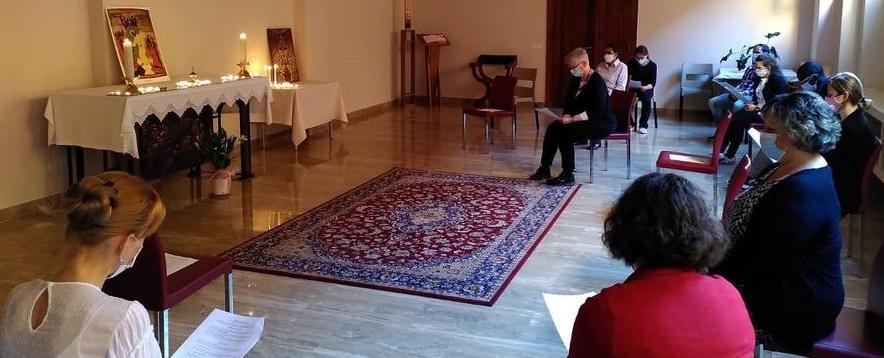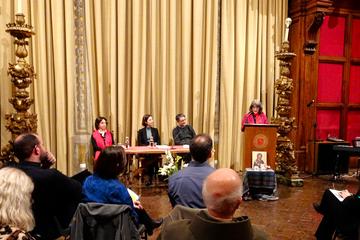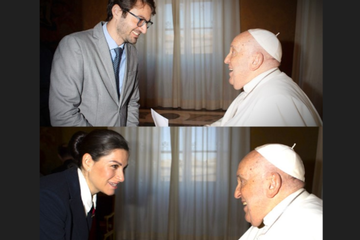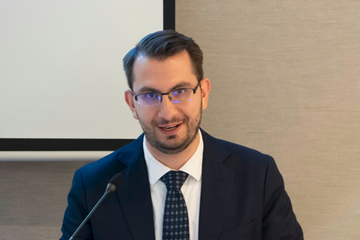
By Heather Walker
ROME — Loredana Fabijanic from Croatia just finished the first year of her social science doctoral program at the Pontifical University of St. Thomas Aquinas. As a Lay Centre Leadership Scholar, focused on faith and liturgy, her aim is to promote community life by being an example through everyday life.
“The organization of liturgical life at The Lay Centre prepares me to accept and work with many different people in diverse and new circumstances,” said Fabijanic. “The Lay Centre has also given me the opportunity to see how important it is to work for ecumenical and interreligious dialogue. It challenges me to live my faith with more authenticity and it truly teaches me to always question my statements and arguments as a constant reminder for me to put myself in other people’s shoes and to see the world through their eyes.”
She went on to explain how she continually discovers that “no matter what religion one belongs to, every liturgy offers something beautiful and new to reflect upon, to contemplate and learn, and one who truly loves God, cannot hate someone who is different, no matter how different they are."
“In fact, the more we encounter diversity, the more we discover our uniqueness. At the same time the greatness of God is revealing itself to us,” she said.
In May, Fabijanic organized a special evening prayer to celebrate Easter on the Julian calendar. Two Eastern Christian Lay Centre scholars, Olena Shust, a Ukrainian Greek Catholic student from Ukraine, who is a doctoral candidate in psychology at the Pontifical Salesian University, and Stergiani Tapaskou, a Greek Orthodox student from Greece, studying Sacred Scripture at the Pontifical Biblical Institute, prepared the hymns for Resurrection Matins, which is central to the celebration of Easter in the Byzantine tradition. The scholars adapted the text so it could be prayed without a priest. Fabijanic said “their contribution and collaboration were fundamental in preparing the liturgy.”
The Lay Centre community read aloud in English, Italian, Spanish, Ukrainian and Greek the liturgical readings and listened to a recording of the Hymn of Light (Exapostilarion) and Praises, sung in Church Slavonic by the choir of monks of the Benedictine Abbey of Chevetogne in Belgium. This monastery, dedicated to praying for Christian unity, welcomes both Eastern and Western Christian monks.
Together with other Lay Centre scholars, Shust, Tapaskou and Fabijanic decorated the chapel with Eastern Christian icons of the crucifixion, the Resurrection, and the Mother of God.
Fabijanic explained: “I would say that the main thing in liturgy is understanding. Sometimes we do not question the things we know, and we take them for granted, even in Roman Catholic liturgy. But I find it very enriching when one asks why we do things the way we do them. This opens up a world of new knowledge. In the liturgy one can experience the faith of the apostles, the fathers of the Church, theology, philosophy, history, art, music, body gestures, garments, silence, spirituality… everything is connected in that moment. Finally, everything, all these elements, lead us to the true experience of the real presence of God.”
Fabijanic said the prayer was very touching for her.
“The students remained in silence in the chapel in front of the icons, as if they were in no hurry to rush off to dinner,” she said. “I think that these moments of silence and peace are something lacking in the lives of contemporary women and men, and something that Eastern liturgy, through soothing chant, candlelight and icons, offers in a special way.”
Shust recalled St. John Paul II, who affirmed that “Eastern and Western churches are the two lungs through which the whole ecumenical Church breathes.”
She said such prayer activity reflects the ecumenical spirit and mission of The Lay Centre.
“The prayer of Easter Canon helped me to be closer to my home and our way of praying and faith in the Ukrainian Greek Catholic tradition, which is very deep from a theological and spiritual point of view,” Shust said. “It was also an opportunity to share its very rich symbolism and spiritual meaning with other members of the community and glorify the Resurrection of Jesus ut unum sint.”
Tapaskou, too, was delighted to take part in the preparation of the liturgy: “It was a beautiful moment of prayer-sharing, which included hymns and readings from the Resurrection Canon. The community was emotionally charged as we celebrated the Resurrection of Jesus for the second time. The reading of all these unique liturgical texts, thanks to the organization and abundant participation, came along with a feeling of refreshment.”
Photo courtesy Lay Centre scholars
Living at The Lay Centre
If you are planning to study at one of the Pontifical Universities in Rome, we'd like to hear from you. The Lay Centre offers much more than just a place to stay.
Write to info@laycentre.org. Click here for more information


